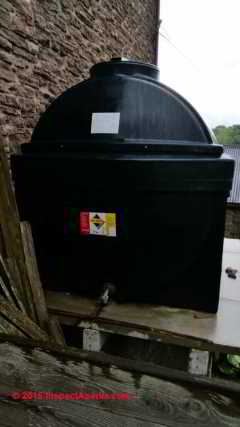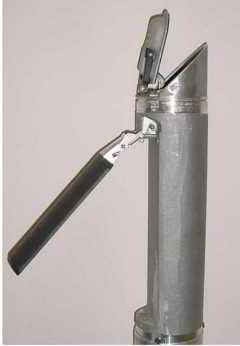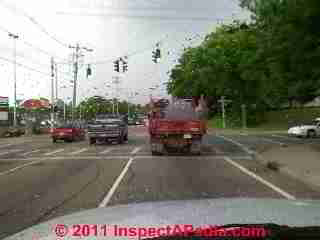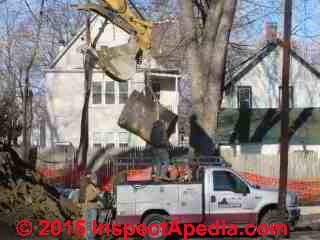 Oil Storage Tank Life Extension
Oil Storage Tank Life Extension
How to Maximize the Service Life of ASTs & USTs - Secrets of a Long and Leak-proof Oil Tank Life
- POST a QUESTION or COMMENT about typical oil storage tank life and factors that affect oil tank durability and leak risk
How to get a long life out of an oil storage tank:
This article lists things you can do to minimize the chances of an oil tank leak or failure due to rust, corrosion, or mechanical damage.
Suggestions are given for life extension of both above ground oil storage tanks and underground or buried oil storage tanks, and for aboveground tanks we discuss both indoor tanks and tanks located outside.
This article series discusses the typical life of oil storage tanks such as tanks used to store No. 2 home heating oil.
Both above-ground oil storage tank life (AST life) and underground storage tank life (UST life) and the factors that determine the life of those tanks are explained. In a discussion of maximizing oil storage tank life - that means minimizing the risk of an oil tank leak - we describe things that can shorten the life of an oil tank can be avoided or corrected.
The photo at page top shows a used AST oil tank being salvaged from a construction job. The contractor told us he intended to use this tank to store fuel for a shop heater.
InspectAPedia tolerates no conflicts of interest. We have no relationship with advertisers, products, or services discussed at this website.
How to Increase the Life of Oil Storage Tanks
 Discussed here:
how to maximize the life expectancy of oil storage tanks.
Discussed here:
how to maximize the life expectancy of oil storage tanks.
How to assure a long service life for above ground oil storage tanks ASTs and for underground storage tanks USTs.
What should you do to minimize the chances of an oil tank leak, rust-out, collapse, or other damage that will require oil tank replacement?
Reader Question: How can I protect my above ground oil tank from rust or decay ?
2015/11/10 Nancy said:
How can I protect my above ground oil tank from rust or decay ? Is there a rust proofing material to spray paint on or other method? The tank is NOT leaking now.
I have another above ground tank that seems to seep as there is odor of oil and small area of staining on the ground. Also this tank is not in use but the supply line (copper) may have oil in it. How can I recover oil in the line ? It goes underground in places.
Reply:
[Click to enlarge any image]
Thank you for the questions, Nancy. Shown here are a pair of used above ground oil storage tanks that were being removed from a construction site.
Dropping an oil tank or bashing it about during handling might not cause it to fail immediately but damage as subtle as a gouge or a bent seam may result in early rust-perforation at that location later in the oil tank's life. Here we will describe steps a home owner or oil tank installer can take to reduce the chances of an oil storage tank failure.
Steps to address small oil tank leaks above ground:
Regarding your concern for small above-ground spills that probably occurred during oil tank fill,
See OIL TANK LEAK & ODOR CAUSES if you think the leaks are occurring at fill and vent pipe connections
See OIL TANK FILL / VENT PIPE LEAK REPAIRS
and
See OIL SPILL CLEANUP / PREVENTION
[Click to enlarge any image]
Watch out: non-trivial oil tank leaks and spills must be reported and cleaned-up properly.
See OIL TANK LEAK & SIZE REPORTING
Steps to increase the life of an oil storage tank and to prevent oil leaks and spills
There are a number of steps that can increase the life of both above ground oil storage tanks (ASTs) and buried or underground storage tanks (USTs).
- Inspect the oil tank for obvious signs of leakage such as at seams and especially at the tank bottom: oil tanks fail principally from corrosion on the inside walls of the tank, near the bottom where water may reside.
If the heating oil storage tank is old or has visual signs of damage or perforation or seeps or drips, it may already need to be replaced. This article series includes oil tank testing procedures that can determine if a tank is leaking or if it is badly-corroded inside. If it's not so corroded one can also buy tank leak insurance.
See OIL TANK INSPECTION CHECKLIST for an easy oil tank inspection guide for above ground tanks.
and
See OIL TANK LEAK TEST METHODS - Remove oil tank water: for an oil tank that passes step 1, check for water in the tank and have that removed (it can be pumped out) if there is more than an inch or so. Articles in this series describe how to check for water in the tank; Small amounts of water can be dispersed using an oil tank additive.
Water in the tank is a significant contributor to tank internal corrosion. See OIL TANK WATER DETECTION
and then
See OIL TANK WATER REMOVAL - Remove oil tank sludge: significant levels of sludge in an oil storage tank can lead to clogs in the oil piping or failures at the oil filter or oil burner, leading thus to loss of heat. Small amounts of sludge can be handled by dispersants and by increasing the oil filter size and capacity.
Sludge removal services can clean sludge from large commercial oil storage tanks.
However sludge removal from residential oil storage tanks usually plays second fiddle to tank replacement. See OIL TANK SLUDGE
and
See OIL TANK TREATMENTS, ADDITIVES - Paint above-ground oil tanks: after removing water, the tank can be cleaned and painted on all sides with a rust-inhibiting paint.
At your hardware or paint supplier you'll find paints that are intended for metal surfaces and that are rust inhibiting. You will need to clean the tank surfaces to remove oil from filling or seepage at the tank piping connections and then the tank will need to be dry.
Spray-painting is easiest but the paint job will be better if you use a brush to work paint into rough surfaces such as at welds and seams.
- Protect above ground oil tanks from water: protect outdoor tanks from roof runoff if the tank is close to the building and be sure that the tank is properly and securely supported above the ground, i.e. the tank should not be in contact with the soil.
The outdoor above ground oil tank shown above is suffering from several ASTAAs - (Above Ground Storage Tank Anxiety Attacks) including exposure to roof spillage from the gutters overhead (note the area of siding that has darkened from water splashing off of the tank top), no protective painting other than the factory primer, collapsing oil tank legs (note the concrete block holding the tank from tipping over and itself forming a wear and corrosion spot near the tank bottom), and outdoor use in a cold climate (Hyde Park, New York) where waxing and jellling may lead to loss of heat (the owner has installed heat tapes on the oil line).
At above right we see the same oil storage tank photographed during winter several years earlier. Snow cover over the oil tank filler risks additional water leaks into the tank added to the water provided by roof spillage.
See OIL TANK WATER PREVENTION
and
see ABOVE GROUND OIL TANK WATER ENTRY
and also
See OIL TANK SUPPORT
If you are considering an installation similar to the oil tank above, also see HEAT TAPES on OIL TANK PIPING - Protect oil tanks from mechanical damage: building codes require that an indoor oil storage tank in a garage be protected from impact by vehicles in the garage, typically by a vertical pipe or an embedded pylon.
It would be smart to prevent oil delivery trucks or other heavy vehicles from driving over or close to buried oil tanks or oil tank piping as soil pressures and disturbance may damage the tank or its piping and thus cause leaks of oil out or water into the tank.
Mark the UST location and install above-ground pylons to keep vehicles at least ten feet away if your UST is in a location where it could be driven-over. Additional protection of underground storage tanks from mechanical damage includes steps taken during tank installation to properly set and bed the tank and to avoid big rocks or sharp objects in the tank backfill.
See OIL TANK, BURIED, ADVICE
also
See OIL or SEPTIC TANKS FLOATING UP - Protect underground oil tanks from water: keep roof spillage and surface runoff away from buried oil tank locations. I've seen basement water entry that mapped specifically to an oil tank buried close to the foundation wall outside.
Because the back-fill around buried oil tank will normally be less dense than surrounding soils, surface runoff or roof drainage that finds that spot will tend to direct water into the tank excavation where water not only adds to tank corrosion but may find its way into a nearby building. See BURIED OIL TANK WATER ENTRY - Protect underground oil tanks from corrosion: underground oil storage tanks, particularly those in contact with corrosive soils, can receive additional protection by connection to a sacrificial anode.
See also OIL TANK LEAK / FAILURE CAUSES - Install oil tank over-fill prevention devices and spillage or leak detectors for the oil storage tank: these devices may be required by local laws depending on where you live. Depending on where you live overfill prevention devices may be referred to by a trade name (SpillStop) or by the more technical term drop tube shutoff valve.
Photographs below. SpillStop Automatic overfill prevention valve, Kingspan Environmental, including offices throughout Europe. Kingspan provides other oil control and spill prevention or detection devices including SonicSignalman, WatchmanAlarm, and WatchmanSonic.
In the U.K. contact: United Kingdom Kingspan Environmental Ltd College Road North, Aston Clinton Aylesbury, Buckinghamshire HP22 5EW United Kingdom Tel: +44 (0) 1296 633000 Fax: +44 (0) 1296 6330
See OIL SPILL CLEANUP / PREVENTION for details about SpillStop and drop tube shutoff valves.
Reader Question: I've seen claims that oil storage tanks last even up to 40 years - who's right?
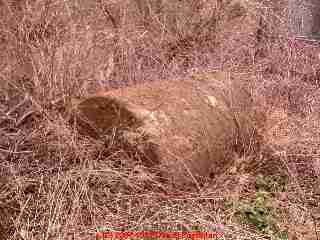
I refer to one of your articles on your website (OIL TANK LIFE, ABOVEGROUND), of which I am curious and very much want to know more. Are there justification to that?
Or it depends on other parameters such as weather and soil conditions? Some websites mentioned that such tank can last even up to 40 years. - M.A., PUB, Singapore National Water Agency
Reply: how long do buried oil tanks last ? ... It depends
Our InspectAPedia photo of an abandoned "buried" oil tank shown at left is an example of a buried oil storage tank that had a very long and leakproof life - until it was abandoned, forgotten, and left empty. Worse the tank had been buried alongside a waterway - a stream in Rhinebeck, NY.
Details are at FLOATING UP OIL STORAGE or SEPTIC TANKS
This oil tank was subjected to very wet soil conditions over several decades, apparently without leaking oil into the environment. But we can't promise the same performance for all buried tanks. It depends ...
In addition to the OIL TANK LIFE, ABOVEGROUND article you cite above, that page, this page, and also OIL TANK TESTING METHODS give research on oil tank leaks and life expectancy as does theReferences or Citations section of each of our oil tank articles.
The oil tank in the back of the truck in the photo above is having the ride of its life. A bit of banging around seems harmless. Is it? Not necessarily.
[Click to enlarge any image]
Thank you for the interesting oil tank life question. Indeed we can find industry sources in the U.S. and Canada that give 50 year life estimates for some types of residential oil storage tanks.
None of those tables considers site conditions or installation snafus, though plumbing connections are mentioned.
A competent onsite inspection by an expert usually finds additional clues that help accurately diagnose a problem or factors that might affect the life of a specific oil tank when at a specific site or oil tank, even before any actual tests for evidence of oil tank leakage. That said, here are some things to consider:
- Industry surveys of oil storage tank life: The data we reported above on oil tank leak rates was based on industry surveys of oil tank age and leak report rates in an area of the U.S. where natural gas is not readily available, where oil heat is most commonly used, and therefore where there was a large population of oil storage tanks.
I agree completely that in certain other environments (cited below) an oil tank may have a longer life than in the north eastern area of the United States.
- The actual life of an oil tank in ground is widely affected by local conditions: soil acidity, water levels, even a scrape or damage during installation. I photographed the oil tank in the back of the delivery truck (above left) as it was being transported - the tank rolled and smashed from side-to-side during its trip to the jobsite.
That banging around could easily have damaged an anti-corrosion protective coating on the tank. Worse, an "indoor-use-rated" oil tank that is installed outdoors, especially buried, is likely be of thinner steel and lack a protective coating against soil moisture and corrosive agents. - An area of wet soils or soils with other than a neutral pH are more of a challenge to oil tank life as are soils that are more conductive (clays, for example) where in urban areas there may be stray electrical currents adding to corrosive factors for the oil tank or its piping fittings.
- The age or generation, and date of manufacture of oil storage tanks can in at least some cases affect the probable durability of the tank.
Oil storage tanks produced several decades ago may have used thicker steel than modern tanks; certainly I've personally observed newer above-ground storage tanks that are made of steel that I could dent with my hand - not something I could (nor would try to) do at oil tanks I've inspected dating from the 1960 and 1970's. - The oil tank life is also affected by what's put into it - oil deliveries containing water, for example, will certainly shorten the tank life. Some conditions that increase the chances of receiving water along with oil during a heating oil or fuel oil delivery including what's going on at the oil storage depot.
- Oil delivery trucks are typically filled from a large oil storage depot tank, often by a river or railroad (via which oil is delivered). Oil storage depots may deliberately keep some water in the bottom of those large storage tanks so that if a tank starts to leak the leak is discovered early - in the form of less-polluting water.
But if the depot tank is near-empty OR if the tank happens to be receiving a shipment of oil being pumped into itself at the same time that the oil delivery truck is obtaining a fill-up, the truck may pick up some water mixed into its own tank.
- Oil delivery trucks are typically filled from a large oil storage depot tank, often by a river or railroad (via which oil is delivered). Oil storage depots may deliberately keep some water in the bottom of those large storage tanks so that if a tank starts to leak the leak is discovered early - in the form of less-polluting water.
- So in the U.S. in Arizona and the dry Southwest, in Central Mexico, Saudi Arabia, or some areas of mainland China where soils are very dry, an oil tank buried in dry ground could certainly have a much longer life than the same tank buried in New England in the U.S.
If you have reason to need an oil storage tank that is resistant to corrosion damage, take a look at some of the fiberglass and other plastic alternatives as well as (more costly) multi-walled oil storage tanks that are required in some jurisdictions and applications.
What is the Legal Definition of "... up to xxx..." Claims in Advertising?
Watch out: about "up to" claims.
Finally, whenever you see someone claiming "... up to ..." you don't really know what to make of such remarks. "Average life of an oil storage tank" is nothing like "... up to... " life. "Up to" after all, could include one single instance of an oil storage tank that was reported to be 40 or 60 or some other age. And meaningless.
Consulting with an advertising attorney in 2010 we learned that there is a legal definition of "up to" claims - at least in advertising case law. You can claim "up to" for a product if 10 percent of the product meets that standard.
So if one oil tank lasted for 40 years somewhere but another nine in the same test set all failed in the first month of service (certainly not really likely), the tank "expert" could still claim that his oil tank installations lasted "up to 40 years".
I appreciate the question and welcome reports of oil tank life from folks in other countries and environments. We are dedicated to making our information as accurate, complete, useful, and unbiased as possible: we very much welcome critique, questions, or content suggestions for our web articles. Working together and exchanging information makes us better informed than any individual can be working alone.
InspectAPedia is an independent publisher of building, environmental, and forensic inspection, diagnosis, and repair information for the public - we have no business nor financial connection with any manufacturer or service provider discussed at our website.
Reader Comments, Questions & Answers About The Article Above
Below you will find questions and answers previously posted on this page at its page bottom reader comment box.
Reader Q&A - also see RECOMMENDED ARTICLES & FAQs
Question:
(Dec 10, 2014) Anonymous said:
some say that a 2mm tank is not good. but if you have a 2.5mm tank is good. but you need a inspection to get oil delivered. My tank is only 10 years old and it like new in basement.They are telling us that we have to change.What are the by-law on this situation.
Reply:
Anon
If there are "by laws" - meaning regulations that apply to your situation they will be defined by your state, province, county, or town. Start with your state DEP or DEC or your local building department when asking about regulations.
Or in More Reading (links just above) see the article series beginning at OIL TANK LEAK & ABANDONMENT REGULATIONS for details.
I am not aware of law or regulation that describes what you report.
Question:
(May 14, 2015) David said:
I have an existing enclosure above ground that has the following volume space for a residential fuel oil storage tank. The volume dimensions are 32” high, 96” long and 72” wide. I prefer the tank to be lined with a non-rusting material to prevent rusting from the inside out. I need a single fuel oil tank that will fit within the above dimensions. The fuel oil filler and vent pipe fittings need to be placed on the top right hand section within (3” to 6”) in from the edge along the (96”) length dimension and no more than (42”) from the right hand corner.
The tank will need to be adjusted in height to allow for the standard filler and vent pipe installation at the top. The tank will also need to accommodate the standard fuel oil fitting for the furnace fuel line feed at the bottom.
The fuel line feed for the furnace should be located anywhere along the bottom edge of the (72”) length adjacent to the corner of the fuel filler and vent pipe fittings. The tank dimensions only need to clear the enclosure dimensions by (2”) for maneuverability for putting the tank in place. I estimate the tank volume to be approximately 1370 cu. Ft. This amount of volume should be sufficient for one season of heating here in New Hampshire. I will hire a licensed well known fuel oil company for the tank installation.
I would be interested in estimated cost and availability. I would appreciate your feedback on this project. I can send a jpeg file for further clarification if required.
Regards,
David Provencher
dproven1@myfairpoint.net
Reply:
David it would make most sense to get cost and availability data from your local storage tank suppliers. We do not sell any product nor service. Doing so would be a conflict of interest with providing unbiased reader information.
Question:
(May 25, 2015) Larry said:
I have a 275 gallon heating oil tank in the basement that just started to drip very slightly from the bottom of the tank its self in the wall of the tank. Is there a repair kit that I can get to put over that spot till I can use the oil up that is in the tank (yup its full )then I want to convert to gas and get rid of the tank
Reply:
Yes there are some clamp on or epoxy repair kits. Watch out about screwing in conventional tank washers and bolts at leak points as you can create a much bigger faster leak.
...
Continue reading at OIL TANK LEAK / FAILURE RATES or select a topic from the closely-related articles below, or see the complete ARTICLE INDEX.
Or see these
Recommended Articles
Suggested citation for this web page
OIL TANK LIFE EXTENSION at InspectApedia.com - online encyclopedia of building & environmental inspection, testing, diagnosis, repair, & problem prevention advice.
Or see this
INDEX to RELATED ARTICLES: ARTICLE INDEX to HEATING OIL, OIL BURNERS, OIL FIRED HEATERS, OIL TANKS
Or use the SEARCH BOX found below to Ask a Question or Search InspectApedia
Ask a Question or Search InspectApedia
Try the search box just below, or if you prefer, post a question or comment in the Comments box below and we will respond promptly.
Search the InspectApedia website
Note: appearance of your Comment below may be delayed: if your comment contains an image, photograph, web link, or text that looks to the software as if it might be a web link, your posting will appear after it has been approved by a moderator. Apologies for the delay.
Only one image can be added per comment but you can post as many comments, and therefore images, as you like.
You will not receive a notification when a response to your question has been posted.
Please bookmark this page to make it easy for you to check back for our response.
Our Comment Box is provided by Countable Web Productions countable.ca
Citations & References
In addition to any citations in the article above, a full list is available on request.
- Thanks to Robert Frank for email discussion about oil storage tank life, 1/21/2010
- [1] Fuel Storage] Tank Corrosion Study, U.S. EPA report on gasoline and oil tank corrosion, James H. Pim, P.E., John M. Searing, Suffolk County DOHS, 15 Horseblock Place, Farmingville Long Island, NY 11728, November 1988, for the Office of Underground Storage Tanks, U.S. EPA. ATTN: David O'Brien. The report presents a study of 500 underground storage tanks spanning 24 February 1987 and September 1 1988 and summarizes earlier reports on this same study. Tank sizes ranged from 175 gallons to 50,000 gallons, and oil tank ages ranged from two years to 70 years old. All 500 oil storage tanks were constructed of welded steel, and 12 other tanks that were other than plain steel were also examined. Summary [with minor edits for clarity by DJF]
- [3] "A Case Study of a Large Scale Precision [oil or fuel] Tank Testing Program", Diane H. Heck, Tetra Tech Richardson, Newark, Delaware, web search 4/27/12, original source: http://info.ngwa.org/GWOL/pdf/870143411.PDF, copy on file as /heating/OIl Tanks UST/Tank_Test_Heck_870143411.pdf
- [4] Fuel Oil and Oil Heat Magazine, August 1985 p.18. Fuel Oil & Oil Heating Magazine, 3621 Hill Rd., Parsippany, NJ 07054, 973-331-9545
- [5] Standards of the National Board of Fire Underwriters, as referenced by "Domestic and Commercial Oil Burners,", Charles H. Burkhardt, 1961, 3rd Ed., McGraw Hill Book Company, p. 172
- [7] "The Interim Prohibition Guidance for Design and Installation of Underground Oil Storage Tanks", U.S. EPA, EPA/530-SW-85203, Office of Underground Storage Tanks, Washington D.C.
- [10] "How do you choose the right tank testing method?", Cynthia Johnson, Fuel Oil & Oil Heat Magazine, November 1995
- [11] National Association of Oil Heat Service Managers, PO Box 380, Elmwood Park, NJ 07407
- [12] "Homeowners Guide to Fuel Storage," Agway Energy Products, Verbank, NY, November 1990
- [13] "Causes of Underground Corrosion", Harco Corporation, Paper HC-36, Median OH
- In addition to citations & references found in this article, see the research citations given at the end of the related articles found at our suggested
CONTINUE READING or RECOMMENDED ARTICLES.
- Carson, Dunlop & Associates Ltd., 120 Carlton Street Suite 407, Toronto ON M5A 4K2. Tel: (416) 964-9415 1-800-268-7070 Email: info@carsondunlop.com. Alan Carson is a past president of ASHI, the American Society of Home Inspectors.
Thanks to Alan Carson and Bob Dunlop, for permission for InspectAPedia to use text excerpts from The HOME REFERENCE BOOK - the Encyclopedia of Homes and to use illustrations from The ILLUSTRATED HOME .
Carson Dunlop Associates provides extensive home inspection education and report writing material. In gratitude we provide links to tsome Carson Dunlop Associates products and services.




